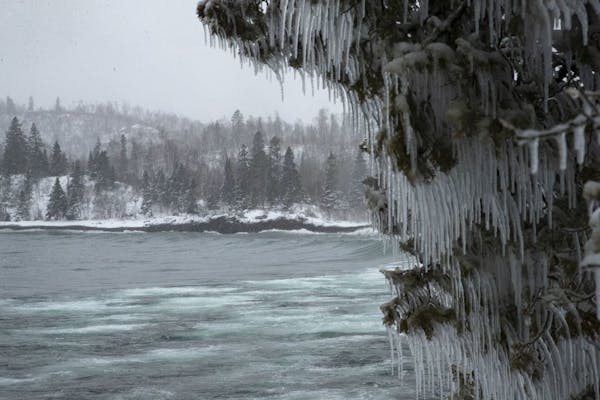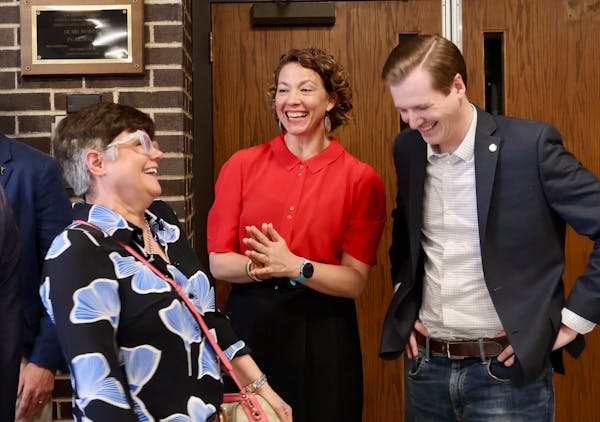DULUTH — U.S. Rep. Jim Oberstar gathered a small group in his Chisholm office in 2002 to discuss plans for passenger rail service between Duluth and the Twin Cities.
In January, 21 years later, a small group was assembled at the State Capitol talking with staffers of DFL House Speaker Melissa Hortman, when she joined them unannounced to share that the Northern Lights Express rail line was a top priority for the 2023 legislative session.
It took two decades of studies and lobbying, in St. Paul and Washington D.C., until there was the necessary mix of supportive politicians and available money. In the last days of the legislative session in May, passenger train service between the Twin Cities and Duluth cleared a major hurdle when the Legislature dedicated $195 million for the 152-mile route.
"It's going to change everything," said Ken Buehler, a member of the Northern Lights Express Alliance. "It's going to be one of the major drivers to revitalize downtown Duluth, and it's going to bring in more tourism than we can imagine."
The Northern Lights Express (NLX), expected to make four daily trips, hinges on securing nearly $800 million in federal funding and the cooperation of railroad owner BNSF Railway and likely Amtrak. But supporters say this is the closest they've been to success. A passenger train connected the Twin Ports to the Twin Cities from 1975 to 1985. In 1999, efforts began to restore service.
"You kind of wondered if this day would ever come," said Bob Manzoline, director of the Minneapolis-Duluth/Superior Passenger Rail Alliance.
Today the Minnesota Department of Transportation (MnDOT) project, praised for its ability to create jobs and reduce the number of vehicles on the road, is considered "shovel ready" proponents say, with an already completed and approved environmental review by the Federal Railroad Administration.
U.S. Sen. Amy Klobuchar said some federal funding has already gone to the Northern Lights Express project for planning, and she continues to push for more money.
"Direct investment in our infrastructure, particularly our passenger rail, plays a critical role in ensuring our local communities can thrive," she said in a statement.
Millions in upgrades, construction
MnDOT is pursuing matching funds from the 2021 federal infrastructure bill, which allocated billions for intercity passenger rail. In all, the project is expected to cost $974 million. Of that, more than $592 million is meant for design and construction, including stations at each of the stops and track and crossing upgrades. The rest is for locomotives, passenger cars and other equipment.
Trains — which will travel at up to 90 mph — would depart Target Field Station in Minneapolis and stop in Coon Rapids, Cambridge, Hinckley, and Superior, Wis., before their final stop at the downtown Duluth Depot. A one-way ticket is expected to cost between $30 and $35, with a trip time of 2.5 hours.
MnDOT projects up to 700,000 riders its first year, with one million after two decades. Those estimates are based on a decade-old cell phone GPS study that tracked travelers moving between intended stops.
When the passenger service could begin operating is unknown, and it depends on federal funding. If it's awarded, it will take a couple of years for planning and about three years to build, said Greg Mathis of MnDOT. Plans include addressing known slow points along the route, he said, and those that need upgrades — such as the Grassy Point Bridge crossing the St. Louis River between Duluth and Superior.
Potential operator Amtrak appears to be on board, but BNSF owns the connecting railroad, and a spokeswoman said the company hadn't had substantive conversations about the project with MnDOT since 2016.
BNSF's freight rail network doesn't use a fixed schedule, Lydia Underdahl said, and the use of its tracks for passengers needs to be analyzed for safety and impacts to freight rail capacity.
"BNSF does not yet know what would be required to host NLX on our freight railroad," Underdahl said, noting the company was resuming conversations with MnDOT soon.
Amtrak doesn't have an official agreement with MnDOT, but the operator is excited about the project, said its Midwestern spokesperson, Marc Magliari,.
With state money also designated for a second daily Amtrak train to Chicago, "the Twin Cities are about to be a rail hub again," he said.
'Ahead of the cart'
Republicans have been critical of the project, questioning its cost, projected use and readiness.
"None of the passenger rail systems that we've had here in Minnesota has ever lived up to their ridership expectations," said Rep. John Petersburg, R-Waseca, GOP minority lead for the House Transportation Finance and Policy Committee.
"My biggest concern is, we've taken $195 million out of the queue that could be used for other things, to put in a plan that isn't even ready yet," he said. "I think we're maybe out a little far ahead of the cart."
Minneapolis DFL vice chair Mike Norton, who said he was speaking for himself, took some heat on Twitter recently when he, too, questioned whether this route made the most fiscal sense.
"I will ride this train," Norton said, acknowledging the benefit of leveraging federal dollars to pay for it. "But if the intent is to take cars off the road or give people access to transit, this probably wasn't the next best project for that. We probably could have served more people, particularly daily commuters, In other parts of the state."
Supporters of the NLX say they expect college students, veterans needing easier access to the VA hospital in Minneapolis, tourists, sports fans, casino-goers, those avoiding a bad-weather drive and families on vacation to use the train.
A Duluth native, Rep. Erin Koegel, DFL-Spring Lake Park, was an author of the House NLX funding package. The push for the train is in response to demand from communities all along the proposed line, she said.
"I think about my 90-year-old grandma living in Silver Bay, and how my uncle could drop her off at the train station and she could come down and visit more often," Koegel said. "It's just allowing people who might not have access to a car or the ability to drive a vehicle more opportunities to get around the state."
The last mile
One issue is how visitors will get around after arriving in Duluth. A new bus transit center is about a block away from the Depot, but a push to boost the availability of shuttles, rideshare drivers, e-bikes and rental cars needs to be made in the coming years so it's all in place when rail service begins, said Andrew Johnson, head of the Northern Lights Express Alliance.
"It's a 15-minute walk to Canal Park. It's got the fundamentals of being located in a good, centralized spot," he said. "It needs additional effort to really make it feel as connected as possible."
Plans for Duluth include a new station next to the historic Depot with a track extension so the station can be used by both the North Shore Scenic Railroad, a seasonal tourist train that travels between Duluth and Two Harbors, and the NLX.

Trail section at one of Minnesota's most iconic spots closing for rehab

Will 'shotgun only' zone for deer in southern Minnesota be abolished?

Four Minnesotans catch salmonella in outbreak linked to basil sold at Trader Joe's


